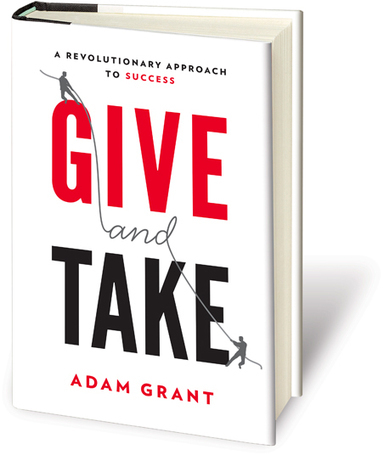 Your new post is loading...
 Your new post is loading...

|
Scooped by
Linda Holroyd
May 3, 2013 2:11 PM
|
Why do we have such a hard time making good choices?" ask Chip and Dan Heath in Decisive.
"A remarkable aspect of your mental life," says Daniel Kahneman, "is that you are rarely stumped." We have opinions about nearly everything and are quick to jump to conclusions based only on the information that is right in front of us. We often just go with our gut. And that hasn't always served us well.
• An estimated 61,535 tattoos were reversed in the United States in 2009.
• Forty-one percent of first marriages end in divorce.
• Forty-four percent of lawyers would not recommend a career in law to young people.
• Eighty-three percent of corporate mergers and acquisitions fail to create any value for shareholders.
The Heath brothers have identified “four villains” when it comes to making decisions: Narrow Framing. We tend to define our choices too narrowly and see them in binary terms. We miss other options. Confirmation Bias. We develop a quick belief about a situation and then seek out information that confirms our belief. When we want something to be true, we look for reasons to justify it. Short-Term Emotion. Our emotions paralyze our decisions. We think we're working it out, when all we have really done is kick up "so much dust that we can't see the way forward." Overconfidence. We think we know more than we actually do. The problem is that we don't know what we don't know. "The future has an uncanny ability to surprise. We can't shine a spotlight on areas when we don't know they exist. What can we do? We can counteract our tendencies with these four strategies the authors call the WRAP Process from the first letter of each step: Widen Our Options. As it turns out, most of the "decisions" we make do not involve any real choice. They are whether-or-not, yes-no decisions. We do not even consider other choices. Like a teenager, we "get stuck thinking about questions like 'Should I go to the party or not?' The party is in their mental spotlight, assessed in isolation, while the other options go unexplored. A more enlightened teen might let the spotlight roam: 'Should I go to the party all night, or go to the movies with a few friends, or attend the basketball game and then drop by the party for a few minutes?' We would benefit by even adding one more option to our "decision." Consider opportunity costs. ("If I do this, then I can't do that?") Or theVanishing Options Test: If you cannot choose any of the current options you're considering, what else could you do. And consider asking others who have "been there done that." Reality-Test Our Assumptions. Encourage constructive disagreement. Consider the opposite. Consider the "outside view"—the averages. If possible, run small experiments to test our theories. Attain Distance Before Deciding. Try the 10/10/10 analysis: How will you feel about your decision 10 minutes from now? How about 10 months? How about 10 years? Also, identify and stick to your core priorities. Perhaps the most powerful question for resolving a personal decisions is, "What would I tell my best friend to do in this situation?" Prepare to Be Wrong. We have to stretch our sense of what the future will bring—both good and bad. Think about the extremes. The future is not a "point"—a single scenario that we must predict. It's a range. Set a tripwire: "We will act when…" a predetermined set point occurs. Making better decisions is a choice. This process will help us to make better choices.

|
Scooped by
Linda Holroyd
May 3, 2013 1:56 PM
|
It’s usually easier to come up with an excuse than it is to actually get something done. I’ve learned that many employees have the potential to be great, but they let excuses get in the way of their true potential. As a leader, it’s important to address these excuses and challenge your employees to be better. Here are some excuses that send my “BS meter” off the charts. You didn’t give me enough direction This is a common excuse for people that are used to checking the answer in the back of the book. The best employees take initiative and require the least amount of direction. The best leaders don’t hold employees’ hands, and the best employees tend to execute well and ask for direction only when it’s necessary. It’s another team member’s fault In school, you didn’t fail to turn in a project just because you had a lazy group member. You picked up the slack. Do what you can to encourage that person to get the work done, and if that’s not possible (there are some really lazy people out there), do it yourself. Bottom line: The best employees simply get the job done. It’s not possible Very rarely do I come across something that isn’t possible. It just takes some critical or outside-the-box thinking. Great employees don’t give this excuse because they don’t give up when they hit a barrier. Sometimes the difference between “impossible” and “possible” is just an email, phone call, or Google search away. It’s a common mistake Some employees think mistakes like typos, grammatical and logistical errors, and email errors are okay because they’re so common. The best employees aren’t “common,” so don’t make “common” mistakes. It pays to double-check your work and make sure it rarely needs correcting. It will put you a step above the rest in a world full of people who are bad at spelling, forming complete sentences, and responding to emails coherently. I need your resources Often, employees rely on their leaders’ resources and network to complete tasks. A standout employee builds off her leader’s connections and establishes her own network. One of the most refreshing feelings for a leader is to see an employee form additional relationships that can help the company. It’s really a feather in the cap to know the employee you trained is successfully branching out and building valuable connections autonomously. The client is unreasonable There is no shortage of difficult people out there, so get used to dealing with them. An unreasonable client or partner shouldn’t mean you can’t accomplish your goals. Valuable employees find ways to deal with unreasonable people simply by forming a better relationship or providing value for the client to ease the unreasonableness. That said, sometimes people who are difficult to work with just need a swift kick in the pants (metaphorically speaking) to bring them back to earth. I need more training When an employee isn’t trained properly, it can result in disaster. All leaders should make an effort to effectively train their employees and have programs that ensure this. Unfortunately, training isn’t 100 percent perfect and some employees won’t be trained properly. Employees also have an obligation to learn on their own and actively try to make themselves better. If an employee isn’t properly trained, the standout employees will fill in the gaps themselves and reap the rewards associated with being awesome. Once you hear these common excuses, it’s important to identify them and address them. Challenging and supporting an employee is one of the best ways to decrease room for these excuses and allow your employees to become great assets for your company. So, even if you don’t have a good “BS meter,” you’ll be able to tell when your employees could be growing instead of consistently falling back when things get tough.

|
Scooped by
Linda Holroyd
April 25, 2013 3:48 PM
|
1. You see the ivy and miss the poison The skilled developer who writes great code… but who also resists taking any direction and refuses to help others… won't instantly turn over a new interpersonal leaf just because you hire him. The skilled salesperson who in the short-term always seems to outperform her peers… but who also maneuvers and manipulates and builds kerosene-soaked bridges just waiting to go up in flames… won’t turn into a relationship building, long-term focused ambassador for your company just because you hire her. The interview process is a little like a honeymoon. You see the best the candidate has to offer. If a prospective employee doesn't look like a great fit for your culture before he is hired, he definitely won’t be after he’s hired. Never risk making a deal with the culture-fit devil. The soul of your company is at stake. 2. You discard the attitude and play the skill card Skills and experience are worthless when not put to use. Knowledge is useless when not shared with others. The smaller your business the more likely you are to be an expert in your field, so transferring those skills to new employees is relatively easy. But you can't train enthusiasm, a solid work ethic, and great interpersonal skills – and those traits can matter a lot more than any skills a candidate brings. According to this study only 11% of the new hires that failed in the first 18 months failed due to deficiencies in technical skills. The majority failed due to lack of motivation, an unwillingness to be coached, or problems with temperament and emotional intelligence. Think of it this way: The candidate who lacks certain hard skills might be a cause for concern, but the candidate who lacks the beliefs and values you need is a giant culture debt red flag. 3. You try to sell a used car It’s tempting to over-sell a candidate on your company, especially when you desperately need to fill an open position and you've been recruiting for seemingly forever. Don’t. Great candidates come prepared. They've done their homework. They already know whether your company is a good fit for them. Describe the position, describe your company, answer every question, be candid and forthright, let your natural enthusiasm show through… and let the candidate make an informed decision. But, don’t oversell. The right candidates recognize the right opportunities – and the right cultural fit. 4. You mistake the rumblings for hunger Nothing beats a formal, thorough, comprehensive hiring process… except, sometimes, a dose of intuition and gut feel. Bottom line: Define the intangibles you want in your employees and never compromise by hiring a candidate who lacks those qualities. 5. You decide to double down There are two basic kinds of risk you can take on a potential employee. First the worthwhile risks: Taking a shot on a candidate you feel has more potential than her previous employer let her show; taking a shot on a candidate who is missing a few skills but has attitude in abundance; taking a chance on a candidate you feel certain brings the enthusiasm, drive, and spirit your team desperately needs. Those are good chances to take. Now the foolish risks: Taking a shot on a candidate with a history of performance issues that you hope will somehow develop a strong work ethic; taking a chance on the candidate who left his last two jobs because "my bosses were jerks;" taking a shot on the candidate who has no experience yet only wants to talk about how quickly and often she will be promoted.

|
Scooped by
Linda Holroyd
April 19, 2013 5:12 PM
|
1. Understand how you’re currently perceived. Many of us think we have this down – but it’s easy to miss something. Google yourself and specifically ask: if this were the only information someone had about me, what impression would she get? It can also be helpful to do your own “360 interviews,” where you specifically ask your boss, trusted co-workers, and colleagues where you’re strong and where you should be focusing more. No, they may not be transparent, but it’s a lot better feedback than you’re likely to get without asking at all. 2. Test-drive your path. Don’t jump right into a reinvention. If you’re thinking of trying a new career or job, take small steps to see if it’s a good fit. You can join a nonprofit board to learn new skills (like finance or marketing), or shadow a professional for a day to see what her job is like. 3. Look for mentors. Many people look for the classic mentor archetype – an older professional sagely guiding you – and get disappointed when they don’t find one. Instead, broaden your viewpoint and develop a group of mentors. They don’t have to be older; it can be anyone you admire and would like to learn from. I formed an Advisory Board of 11 mentors a year ago – and it’s been hugely successful. 4. Don’t be afraid to go backwards temporarily. When you reinvent yourself, you may have to downshift in the short term – maybe taking a pay cut in a new field, or having to take on additional projects to prove yourself. Don’t stress out: if you’re moving in the direction you want to go, it’ll pay off in the long term. 5. Use social media to build connections. Social media is the great equalizer- you can send anyone a tweet or comment on their blog, and they’re likely to respond back. When you’re entering a new field (or a higher echelon of your current one), relationships are everything, and social media can help you develop them rapidly. 6. Show what you know. As “knowledge workers,” it can sometimes be hard to demonstrate what we’re really capable of. So act like an artist and develop your own portfolio. Start a blog or find other ways to create content (white papers, podcasts, a great Twitter feed) and let the world see what you care about, what you know about and what your perspective is. 7. Get a wingman. Psychology research shows (no surprise) that people who talk about their own accomplishments are viewed unfavorably; no one likes a braggart. But if someone else touts your accomplishments, you’re golden. So find a like-minded friend or colleague and make a pact to talk each other up. You’re likely to notice an immediate difference, as more people become aware of your skills, abilities, and accomplishments.

|
Scooped by
Linda Holroyd
April 19, 2013 5:07 PM
|
unilateral escalations, have more negative consequences. First, they waste everybody’s time – especially the manager’s. Instead of one round of discussions, at least two or three are required. Second, they create bad blood between the team members. Each believes that the other is going behind his or her back to lobby the boss, and rightly so. Third, they foster a political culture where everybody strives to secure a 500-pound gorilla – the manager – to play for their team. To avoid end runs, I advise my clients to establish the following principles: Information is free. Everybody can speak to anybody about any issue they find relevant.If two people have a conflict they must first try to solve it among themselves throughinterest-based negotiation.If they can’t reach an agreement, they must bring the problem to their manager together. (If they don't report to the same manager, they must call a meeting and present the problem to the two managers together.)They must present the disagreement as a shared narrative with alternative resolutions, highlighting the trade-offs they cannot resolve without the manager’s help.If one of the parties (e.g. Sally) refuses to escalate jointly, the other must inform her that he’ll do it alone and invite her, once again, to bring the matter “up” together.If the reluctant party continues to refuse, the other can then escalate unilaterally. To support this process, the manager must refuse to listen to any argument brought to her unilaterally unless she obtains an affirmative answer to the following questions: “Have you and your colleague tried to resolve this problem using constructive negotiation?” If the answer is “no,” then, “Please try that first.”“Have you invited your colleague to come escalate the problem with you?” If the answer is “no,” then, “Please invite him first.”“Have you told your colleague that if he didn’t come with you, you would bring the problem to me alone?” If the answer is “no,” then “Please tell him first.”

|
Scooped by
Linda Holroyd
April 17, 2013 12:27 PM
|
Your ability to create focus. A leader should strive to paint an inspiring vision. Most people don't want to run from something, but rather they seek to run to something. As individuals, we want to be a part of something greater than themselves. A leader should paint this inspiring vision, and then articulate the priorities to help help people know how to make progress against that vision. Your interactions should produce the three E’s. The second thing I believe underpins scaling leadership is your interaction model. My view is the outcomes a scalable leader should create in every interaction is the three E's: Energize: You should leave people with their hearts beating faster. This does not mean always being a cheerleader. In fact, constructive feedback and course adjustments can be equally stimulating if they are delivered in the form of coaching, versus judging. Seek to energize in every interaction. Educate: Leave every encounter with the team having learned at least one thing they didn’t know (or had not realized) before you met with them. You should also seek to learn at least one thing you didn’t know as well. Scalable leaders use every opportunity to learn and to teach. Empower: Scalable leaders measure success, not by what happened in the meeting, but how capable the team is able to execute without them after they leave the room. Did you build capability during the interaction? The secret to the three E's is principles-based decision making. Bring your coaching to the level of guiding principles. That way, the next time a team faces a similar situation they can refer to the principles as guidelines, and will have a better sense of what to do. How you invest your time. The third and final piece to scalable leadership is how you choose to invest your time. As leaders, the resources we leverage include time, people, and dollars. We can often find more people and more dollars, but we can never manufacture more time. It is so critical to be very discerning about where you’ll invest your time for two reasons. It is your most scarce resource, so getting the maximum ROI is essential. It is also the strongest signal you can send to a team around what you deem to be the most important. So to scale your leadership as your organization grows, create focus through an inspiring vision. Be clear about your interaction model and the three E's. And keep a close eye on how you spend your time.

|
Scooped by
Linda Holroyd
April 15, 2013 12:13 PM
|
We came up with this set of principles for making sound decisions under pressure: 1. Remove the rose-colored glasses: A good cost-benefit appraisal can be trickier than you think. Why? Because most of us tend to underestimate costs and overestimate benefits – and to be generally optimistic about our ability to make things happen. Our analyses inevitably bend toward the outcomes we’re hopingfor. Good decision-makers are wary of wishful thinking. Get a second or third opinion from skeptics you trust — the advisors who'll push back and make you defend your assessments. 2. Wield the red pen ruthlessly: When it comes to picking ideas, separate the elephants from the ants. Cross off everything but the top few priorities, and make sure you haven’t fallen in love with pet projects and ‘hobbies’ whose time may have passed. When it’s clear a pet project is ailing, hurry up and get out the rifle (so to speak). As I covered in a recent post, a few, clear, simple goals are more likely to yield results than complex “perfect decisions” that can bog down an organization. 3. Don’t fall in love with percentages: Everyone likes a tenfold return, but you’re not going to be noticed by the Wall Street Journal for turning $10,000 into $100,000. A mere doubling of $500 million into $1 billion, however, could be worth spilling some ink over. In many business decisions, it’s the long-term return that matters, and the highest absolute benefit wins over the highest percentage benefit. 4. Don’t delay the decision: Time is rarely on your side. I’ve yet to hear an executive say he made a tough call too soon. The same goes for making personnel decisions: if you’re not looking for ways to promote or keep current team members, it may be time to think about replacing them. 5. Feel the fear and do it anyway: Be careful about letting your feelings warp your perception of the situation. Fear can make you freeze up; but in almost every case, it’s better to make a call and deal with consequences than to leave things in limbo. Look the circumstances squarely in the face. As Winston Churchill said, "courage is the first of human qualities because it is the quality which guarantees all others.” 6. What would Kant do? It should go without saying that you want your decision to be an ethical one. So if your ethical compass needs a bit more calibrating, remember Immanuel Kant. His “categorical imperative” is a useful thought experiment to help you decide if you’re doing the right thing. It’s a bit like “The Golden Rule” on steroids: what if everyone in the world, in your shoes, always made the same choice you’re about to make? If that's a world you’d want to live in, you’re okay in Kant’s book. 7. But can you execute it? Good decisions can become great ones if you execute them well. So for every one of your options, think about whether it’ll be easy to explain to your team and your organization, or if it’s likely to be lost in translation. Will people be enthusiastic about making it happen? If not, maybe the idea's not as good as it looked on paper. 8. Think forward: Don’t relive past decisions – good or bad. Circumstances change, people change, and you change. Dwelling on past glories or failures is dangerous and unproductive. 9. Borrow wisdom: You’re probably not the first person to face a given predicament, so seek out anyone who might have been there before. Mentors have seen a lot of things – find a good one if you can. And make a habit of reading about how past leaders made momentous choices. Many of us have come to rely on our instincts to cut through the jungle of choices we face every day. Be careful, though: good intuition is not the same as good decision-making. In business, intuition works, but only in conjunction with calculation. Like a chess master, you should pick your move after weighing the outcomes. Then make it, implement it, and start thinking about the next one.

|
Scooped by
Linda Holroyd
April 9, 2013 9:01 PM
|
Balance: “Balance operates through a constant stream of choices.” Balance is often thought to mean finding the middle ground. That’s not balance, that’s compromise. In order to find the middle ground, our choices “can too easily drift toward the middle in a cowardly compromise of nothingness. Balance backfires when it moves from being about bold, sometimes tough, choices to being about bland compromises.”
Collaboration: Collaboration should be accountable not automatic. “The default state of working should be alone; leaders should collaborate only when they must. Depending on your role, that may mean a significant part of your job requires collaboration. But ask yourself the question: does this work really need more than me?
Creativity: We all like creativity. It’s fun and exciting. But creativity needs to be useful and meet a real need or it’s just narcissistic creativity—creativity to serve our legacy. “Creativity should be pragmatic, not prideful.”
Excellence: Our pursuit of excellence “backfires when our high standards choke progress.” Forcing excellence on the process rather than the outcome.
Fairness: “Fairness backfires when some of our noblest instincts force us to ensure equitable outcomes rather than equitable processes.” Keeping score and evening the score to make sure no one gets more than their "fair share" often leads to regrets.
Passion: Bad passion crowds out everything else causing you to ruminate on one thing at the expense of others. Healthy passion is part of a diverse set of traits. Passion backfires when it becomes obsessive.
Preparation: The problem here is with too much backstage preparation. Preparation is critical but sometimes the best work is done in real-time—onstage preparation—learning while you are doing.

|
Scooped by
Linda Holroyd
April 5, 2013 1:59 PM
|
“Success is to be measured not so much by the position that one has reached in life as by the obstacles which he has overcome.”Whether in business or life, there's a fine line between 1. Fail. No matter how hard you work, failure can and will happen. The most successful people understand the reality of failure, and its importance in finding success. Rather than running and hiding when you fail, embrace it. Learn from this mistake and you won’t fail in the same way again. 2. Set goals. Those who are successful set daily achievable goals. Find success by solidifying S.M.A.R.T. -- smart, measurable, attainable, realistic, timely -- goals. Stop juggling a mental to-do list of just long-term goals and establish small daily goals to achieve your vision. 3. Don’t rely on luck. Many relate success to being in the right place at the right time. While this is an element of success, there’s also the crucial involvement of blood, sweat, and tears. Don’t hold yourself back by waiting for the perfect timing or idea. Some of the most successful people got there by hitting the ground running, even if timing wasn’t perfect. 4. Track progress. Success comes from regularly monitoring behaviors, strategies, and tactics. How can you make adjustments if you don’t know how you’re doing? Hold yourself accountable by checking your progress as often as possible. 5. Act. Successful people don’t always know the right answer, but the keep moving anyway. Don’t let obstacles stall you when you’re searching for the right solution. Taking action will lead to answers. 6. Connect the dots. Those who are successful have the ability to see the greater picture. They identify and connect the tiny details to get there. Look at things in a “past, present, and future” context to receive favorable results. 7. Display realistic optimism. Those who succeed truly believe in their abilities. This respectfully drives them forward. Assess your abilities to gain a clear understanding of what you are able to accomplish. This will allow you balance yourself through the aid of find someone or something else. 8. Continued improvement. Successful people habitually thrive on self-improvement, whether it’s in terms of learning from mistakes or simply using their weaknesses as opportunities. Channel this habit by continually searching for ways to be better. Maybe your networking skills are rusty or you need some extra training -- set goals for improving your weak spots. 9. Commit. Success doesn’t come without effort. The most successful individuals are often the most committed to what they’re working toward. Throw yourself into your tasks and go the extra mile every single day. Make no exceptions. 10. Be alert. A keen sense of awareness breeds success. If you’re not keyed into your environment, you’re sure to miss opportunities. Do you know what’s being said within your company, feedback from clients, or even in your entire industry? 11. Persevere. Truly successful people never give up. Do they ever fail? Yes. But as times get hard, their stamina to move forward doesn’t wane. Develop a willingness to work through the challenges you encounter along the way. 12. Communicate with confidence. Those who are successful have an ease for convincing others. They don’t manipulate or pressure, but logically explain the benefits. Communicating with confidence will allow you to more easily negotiate your visions. 13. Display humility. The most successful individuals lack an ego. It’s their fault when they fail. Hold yourself accountable for every aspect of your life by focusing on remaining focused and humble. 14. Be flexible. Plans may change. Successful people roll with the punches. Rather than getting frustrated, swiftly maneuver in another direction. 15. Make connections. Successful people often attribute their achievements to the help of others. You can’t and won’t be able to do this alone. Invest in generating mutually beneficial business connections and partners. Even if you have all the skills necessary to run your company, a business partner could complement your weaknesses.

|
Scooped by
Linda Holroyd
April 2, 2013 4:24 PM
|
1. Relationships require listening. Relationships -- with customers, employees, or lovers -- involve a give-and-take. Each party has to listen to the other, which is something women seem to be much better at than men (in my own experience, just sayin'). So instead of crafting algorithms and spreadsheets to plot which of your customers are the most and least valuable to you (a macho management preoccupation), design some "Golden Questions" for your customers, so you can listen better to what they say they really need! 2. Think long-term. Short-term thinking is macho-management at its best and probably the single most threatening affliction for business executives (and politicians) today. But relationships aren’t built quickly, and they grow stronger with time. For a business, customers are the mechanism that links short-term actions and long-term value, because customers have memories, and how you treat them today will affect how much value they create for you tomorrow. 3. Hierarchies are out. Collaboration is in. For the last two hundred years or so, corporate organizations were strictly hierarchical, with authority flowing down from the top, while information flowed up from the bottom. No longer. Today, the lowliest employee can jump the hierarchy with a tap to her smartphone. Top-down organization, as a form of command-and-control macho management, is fading fast. 4. Rules and structure don’t matter. Culture and informal customs make the difference now. Automation is a macho mechanism for streamlining predictable processes and accomplishing tasks. But in a more rapidly changing world, with ever more unpredictable innovations and disruptions, dealing with unanticipated situations will be more important. Culture – the unwritten rules that govern how an organization’s members behave – will be the single most important factor in determining how your organization weathers the next unexpected social media conflagration or disruptive innovation. 5. Empathy is king. Macho management principles allow a business to pad its current-period bottom line by exploiting a customer’s mistakes, oversights, or lack of knowledge. But relationships succeed based on mutual empathy, which for a business means seeing things from the customer’s perspective, treating different customers differently, and demonstrating genuinely good intentions toward them. Proactively protecting the customer's interest is the new standard. 6. Share and be shared with. In the e-social era, with technology-facilitated relationships blossoming all around us, remember that people have an urge to share, so macho-inspired monetary incentives and purely economic inducements are not always useful. In the social domain, in fact, they can be counter-productive. Share your ideas, your technology, and your data, in order to inspire more sharing and faster innovation. And begin figuring out what it means to trust others the way you want them to trust you.

|
Scooped by
Linda Holroyd
March 22, 2013 12:36 PM
|
Foster ownership behavior. Contrary to popular belief, more money is not the thing the best employees want most. In many cases, they would be happier if they had more ownership over their work. When leaders give these employees freedom to take control of their work, their creativity flourishes and they become more entrepreneurial.Build community. Inside and outside of organizations, entrepreneurship best thrives within tribes. Employees need groups in which to collaborate and confide as they think of and try out ideas.Pursue rapid and continuous experimentation. Organizations that want to encourage entrepreneurship need to have a cultural tolerance for changing course. If you try an idea and it doesn’t work out, that needs to be taken as a sign to go in a different direction, not a hallmark of failure.Cultivate intentional opposition. Frequently, leaders oppose ideas “because that’s the way we’ve always done things.” Instead, they need to provide intentional opposition, playing devil’s advocate to employees as they innovate to boost creativity and take ideas in different directions.Embrace new metrics. Traditional metrics can lead to entrepreneurial experiments being marked as failures, which then discourages additional experimentation that could lead to major success. Organizations need new metrics that encourage entrepreneurship and demonstrate its overall positive effect.Protect social capital of others. Reputation is everything within a large organization, and no one wants to be seen as a failure. If organizations want employees to experiment and be entrepreneurial, they need to protect a worker’s reputation when not every idea pans out.

|
Scooped by
Linda Holroyd
March 22, 2013 12:09 PM
|
What if instead we built our strategy around the solid majority of good guys — the ones we trust. Those people who: care deeply about doing a good jobunderstand the strategy when you explain itget that businesses also need to make profitsrun productive families and are active in the communitymay even teach our children in Sunday school

|
Scooped by
Linda Holroyd
March 18, 2013 3:00 PM
|
As technology continues to impact our lives, workers in today’s ever-changing labor market need to be prepared with skills to adapt and succeed in the workplace... Mobile Hardware, Software and Services will continue to rapidly evolve creating many new careers, asall phones become smartphones and our primary computer and tablets continue to evolve as our laptop replacement.This new level of mobility will allow any size business to transform how they market, sell, communicate, collaborate, educate, train, and innovate.Remote Visual Communications will become a primary relationship-building tool for businesses of all sizes asemployees use smartphones, tablets, and laptops, in combination with current video conferencing systems, to communicate at new levels with customers, partners, and employees.Social Business Enterprise Management will grow rapidly as organizations shift from an Information Age “informing”model to a Communication Age “communicating and engaging” model. New careers will emerge as Social Software for business rapidly grows with applications to enhance relationships, collaboration, networking, social validation, and more. Social Search will increasingly shape careers as marketers, researchers and those on Wall Street create applications and services to tap into millions of daily tweets and Facebook conversations, providing real-time analysis of many key consumer metrics.Cyber Security and Forensics careerswill grow rapidly as we become increasingly connected and dependent on computer systems and machines using intelligent sensors connected to just about everything. Careers in data and information forensics will grow rapidly as the need to solve cyber crimes increases.Additive Manufacturing (3D Printing) will create many new careers in manufacturing as this revolutionary technology allows any size company to manufacture quickly, locally and with far fewer costs. Additive manufacturing builds things by depositing material, typically plastic or metal, layer by layer until the final product is finished. Examples of final products today include jewelry, iPhone cases, shoes, car dashboards, parts for jet engines, prosthetic limbs and much more.Gamification of Education will create many new careers as corporations and educational institutions at all levels accelerate learning by using advanced simulations and skill-based learning systems that are self-diagnostic, interactive, game-like, and competitive, all focused on giving the user an immersive experience thanks to a photo-realistic 3D interface.Cloud Services and Virtualization will be increasingly embraced by businesses of all sizes, as this represents a major shift in how organizations obtain and maintain software, hardware, and computing capacity. IT is rapidly becoming an on-demand service that is rapidly transforming all business processes resulting in a rapid evolution of current careers as well as creating new careers in every functional area.Big Data and Real-Time Analytics describe the technologies and techniques used to capture and utilize the exponentially increasing streams of datawith the goal ofbringing enterprise-wide visibility and insights to make rapid critical decisions. This new level of data integration and analytics will require many new skills and cross-functional training in order to take advantage of new opportunities as well as breakdown the many data and organizational silos that still exist.Intelligent ePersonal Assistants using natural language voice commands was launched with Apple’s Siri, which was rapidly followed by Google, Microsoft, and others all offering what will become a mobile electronic concierge on your phone, tablet, and television. The technology will rapidly evolve and soon every profession from retailers to maintenance workers will have a Siri-like assistant. Adding an e-personal assistant to support an existing product and/or service will create many new careers.3D Web will transform today’s Internet experience (which is like looking at a flat piece of paper with a few photos, embedded video, and a few hyperlinks) to a true 3D experience, similar to todays video games, where you can virtually walk into a showroom, look around and both listen to and see the new car you are interested in, or whatever the website is trying to show you. This will employ many new graphic artists, designers and programmers.Connected Intelligent Objects using chips, microsensors and both wired and wireless networks will create a rapidly growing “Internet of things” sharing real-time data, performing diagnostics, and making remote repairs. Many jobs will be created as we add intelligent connected sensors to bridges, roads, buildings, homes and much more. By 2020, there will be well over a billion machines talking to each other and people will install them.Advanced Robotics and Automation will take a giant leap forward thanks to networked sensors, artificial intelligence, and Siri-like voice communications, taking the next level of repetitive jobs from humans. This will create many new career opportunities from design, programming, and installation to service and maintenance, to name just a few.
|

|
Scooped by
Linda Holroyd
May 3, 2013 2:06 PM
|
Managers cannot make work meaningful for employees. Managers, however, can shape the workplace environment to let meaningful work become possible for employees. With a context set to let meaning be experienced, employees can leverage the environment to derive meaning from their work. Meaningful work is vague. What exactly is it? Assuredly it begins quite selfishly. But this is out of necessity. For work to be meaningful, it is the employee who must label it so. This requires a belief that meaningful work is a desired outcome from managements’ actions. And employees believe managements’ intentions and see actions aimed to let meaning emerge. For work to be meaningful, it is the employee who must label it so To explain what meaningful work is, let’s look at its characteristics. In short, however, meaningful work is employees’ perceived positive value of what they are doing. It’s a source of joy in their overall life. In the words of Max Depree, “[it’s] maturing, enriching, and fulfilling, healing, and joyful.” Basic needs are met Think Maslow’s hierarchy of needs. Employees physiological and safety needs must be met. It’s a base requirement for meaningful work to emerge. Strengths are leveraged Don’t confuse strengths with competency. Strengths are what energize you. Employees must experience work that energizes them. Otherwise all work is draining and meaning is absent. Don’t confuse strengths with competency Pull personal satisfaction from work Employees’ perceive their work to be fulfilling. Being in on things Employees believe they are trusted with important, inside knowledge. This includes knowing that there is important information but it must be kept confidential from employees for the benefit of the organization. Treated with respect by peers and managers This doesn’t say liked, but respected. There is a difference. At its core is employees’ believe they can speak their ideas and be in action to achieve the best possible outcomes. See how one’s work fits into the bigger picture Really, what hasn’t been said or written about this. Enough said. Personal sense of independence and interdependence Autonomy in completing one’s work has always been important. Collaboration is vital in the 21st century given the internet and globalization. These raise the importance of interdependence in today’s workplaces. Employees believe they are valued by the organization, by management To be viewed as a replaceable cog in the proverbial wheel is antiquated management. Organizations thrive or die based on human actions. To that end, meaningful work is marked by the belief that employees are the means to a profitable end. To be viewed as a replaceable cog in the proverbial wheel is antiquated management Opportunities to know self Let’s look back to Max Depree’s words. For work to be meaningful, there must be a maturing nature of work. Such an evolving awareness of the nature of work is best met by an evolving, deepening awareness of one’s self. Coaching, feedback and awareness of one’s place in the universe are vital to make sense of meaningful work. Such opportunities are humbling. Promotion of other’s satisfaction Immanuel Kant, philosopher, placed our ability to be concerned for other’s wellbeing and humanity as important to meaningful work. Such a belief places an emphasis on a strong, united team supporting others’ ability to flourish. Recognized, give recognition for good work For meaningful work to emerge, employees’ efforts are recognized in manners important to the person. Furthermore, giving recognition is believed to matter, creating a cycle of reciprocity that is genuine. In today’s workplace, meaningful work is radical. For some managers, to influence a meaningful workplace environment is heretical. This is precisely what our workplaces need.

|
Scooped by
Linda Holroyd
May 1, 2013 11:40 AM
|
This month, our leadership blog will work in conjunction with our marketing blog with the same theme: Getting from Here to There. This leadership blog will focus more on the people aspects of it: Who Gets From Here to There, and the marketing blog will focus on the company aspects of it: Getting Your Company From Here to There. The best leaders have a high level of self-awareness and embrace and understand their strengths and shortcomings. But they also understand the skills and talents of others around them, and are relied upon to accurately and quickly discern who on their team or in their network can help the team/product organization from here to there. Below are some guidelines to help make astute assessments about who can get from here to there.
Values-Alignment 1. The first filter is always about the ethics and values of the people you’re working with. If someone does not fit within the cultural and moral expectations of a group overall, or doesn’t fit within the overarching direction defined by the group leaders, he or she will never get from here to there, despite the best efforts on everyone’s behalf. 2. Even if the skills and passion are there, sometimes the fit-within-the-team is not. Team dynamics should be in alignment with the leaders expressed goals, and proactively managed to ensure successful execution at a team level, and personal and professional accomplishments at the individual level. And sometimes the best performers may not perform well even in the best teams. Skills and Abilities 3. A hallmark trait of a good manager is someone who hires and develops people with the skills and abilities to get the job done, and even to grow with the job. Each manager has his or her unique combination of quantitative and qualitative evaluation tools to select for those who can get the job done well the first time, and no effective manager would hire someone without the confidence that she/he is qualified to perform the job. 4. Even if you are certain that the skills are present, hire for someone who is teachable and open to learning new approaches, technologies and processes. This is particularly true as technology changes, business model evolutions, and the way business is done keeps evolving and changing. 5. But what if he or she is hiring someone with adjacent, but not direct experience in a specific role? In these instances, it is important to rely more heavily on qualitative evaluations, and the recommendations of trusted others. Consider also having a probation period or a consulting project prior to hiring someone full time into this role. 6. And what if she or he is hiring for a new role, where there are few people with the background skills and abilities to perform the job well from day one? In these instances, consider prerequisite qualifications in terms of experience and training. Brainstorm with others about what technical, leadership and process skills would be good indicators of success in a newly defined role or area. Clearly define what success looks like.
Drive, Passion and Purpose 7. Successful people have an intrinsic desire and drive to succeed. They approach projects with energy and are persistent and successful in achieving measurable goals. Watch out for those who are only seeking external rewards for specific tasks performed, particularly if you are not sure of the values they stand for. 8. With that said, people express drive and passion in different ways. Just because someone does not appear as energetic as someone else doesn’t mean that the less passionate is less driven. Indeed, the focus should be on the results, not the fanfare and the noise. 9.. Beyond the skills and abilities and values, look also at the passion and fit between someone and the role he/she currently has. 10. Providing stretch goals in alignment with her/his passion and purpose is one way to help ensure engagement and success. It’s no easy task to decide for yourself who can get from here to there. But continually reviewing values, skills and passion will help you, as a leader, to get a high level view of the people who will take the team and organization forward.

|
Scooped by
Linda Holroyd
April 19, 2013 5:25 PM
|
KNOW YOURSELF
Clark takes you through the whole process, beginning with, of course, starting where you are. This is a vital step and not to be glossed over because many of us don’t know where we are starting. We need you understand our reputation and why it is what it is. She offers ways to do this, questions to ask and how to conduct your own 360 interview—determining what those around you think about you. Very valuable material.
Next you need to research your next move or future destination and test drive it. (Did you know that there is a company that allows you to test-drive over 125 new careers to see if they are a fit?)
Once you have determined where you need to be, it is important to develop the skills you need. Clark explains how to do this and when to go back to school and when not to, and finding a mentor (someone who embodies what you’d like to develop and the person you’d like to become).
LEVERAGE YOUR POINTS OF DIFFERENCE
Rebranding yourself publicly means understanding first, what is unique about you. It may not be what you think. Often it's the mindsets and thinking that proved valuable in your current situation may differentiate you in a completely unrelated field. The examples of people that Clark provides, who have done just that, are very helpful in getting you to see your unique contribution.
From that you can build your narrative that pulls together the underlying themes that connect your professional experiences in a way that is obvious to others.
THE GAP
There is a time lag–a gap–between fully inhabiting the “old you” and the “new you.” Clark writes that the “hardest part of making a transition can be bridging the gap between how others used to perceive you (and how you perceive yourself) and how you’d like to be seen moving forward.” She say the only solution is to fake it till you make it.
I’m sure that we have all experienced this dynamic when making any personal change. When no one readily accepts the nice person you have finally become, it’s easy to give it up and resort to the old habits of behavior. The answer is to keep projecting the new behavior until you’re comfortable with it and others begin to accept it as the new “normal.” Your commitment to the new you will eventually win people over.
Clark adds, “You need to be hyperaware of what you’re doing and make sure you’re signaling explicitly to the outside world what you’re trying to build.” This is where doing the homework in step one—know yourself—will help you to have the fortitude to press on.
Clark explains how to get the word out and how to prove your worth. She reminds us that rebranding is a process and not a one-time activity. It is important to “keep monitoring your reputation to ensure you’re being perceived by others the way you’d like.” This is a well done and thoughtful book that is valuable not just for rebranding yourself but also for managing your reputation in general.
Reputation management is not as straight-forward as it once was. The behavior is the same, the tools are different. In addition, says Dorie Clark, it’s almost certain that at some point you’ll need to reinvent yourself professionally—and ensure that others recognize the powerful contribution you can make.

|
Scooped by
Linda Holroyd
April 19, 2013 5:08 PM
|
1. "To lead people, walk beside them ... As for the best leaders, the people do not notice their existence. The next best, the people honor and praise. The next, the people fear; and the next, the people hate ... When the best leader's work is done the people say, 'We did it ourselves!”— Lao-tsu 2. "Leaders must be close enough to relate to others, but far enough ahead to motivate them.” — John Maxwell 3. "Dictators ride to and fro upon tigers which they dare not dismount. And the tigers are getting hungry.”— Winston Churchill 4. "Control is not leadership; management is not leadership; leadership is leadership. If you seek to lead, invest at least 50% of your time in leading yourself—your own purpose, ethics, principles, motivation, conduct. Invest at least 20% leading those with authority over you and 15% leading your peers." — Dee Hock, Founder and CEO Emeritus, Visa 5. "All of the great leaders have had one characteristic in common: it was the willingness to confront unequivocally the major anxiety of their people in their time. This, and not much else, is the essence of leadership.”— John Kenneth Galbraith 6. "If a rhinoceros were to enter this restaurant now, there is no denying he would have great power here. But I should be the first to rise and assure him that he had no authority whatever." — G.K. Chesterton to Alexander Woollcott 7. "The task of the leader is to get his people from where they are to where they have not been.” — Henry Kissinger 8. "The task of leadership is not to put greatness into humanity, but to elicit it, for the greatness is already there." — John Buchan 9. "Leadership is the art of getting someone else to do something you want done because he wants to do it.” — Dwight D. Eisenhower 10. "The best is he who calls men to the best. And those who heed the call are also blessed. But worthless who call not, heed not, but rest." — Hesiod, 8th Century BC Greek poet 11. "Never give an order that can't be obeyed." — General Douglas MacArthur 12. "Leadership must be based on goodwill. Goodwill does not mean posturing and, least of all, pandering to the mob. It means obvious and wholehearted commitment to helping followers. We are tired of leaders we fear, tired of leaders we love, and of tired of leaders who let us take liberties with them. What we need for leaders are men of the heart who are so helpful that they, in effect, do away with the need of their jobs. But leaders like that are never out of a job, never out of followers. Strange as it sounds, great leaders gain authority by giving it away.” — Admiral James B. Stockdale 13. "Great leaders are almost always great simplifiers, who can cut through argument, debate, and doubt to offer a solution everybody can understand." — General Colin Powell 14. "Men make history and not the other way around. In periods where there is no leadership, society stands still. Progress occurs when courageous, skillful leaders seize the opportunity to change things for the better.” — Harry Truman 15. "Leadership is intentional influence." — Michael McKinney 16. "The leader is one who mobilizes others toward a goal shared by leaders and followers. ... Leaders, followers and goals make up the three equally necessary supports for leadership." — Gary Wills, Certain Trumpets: The Call of Leaders 17. "All Leadership is influence.” — John C. Maxwell, Injoy, Inc. 18. "You cannot be a leader, and ask other people to follow you, unless you know how to follow, too." — Sam Rayburn 19. "Your position never gives you the right to command. It only imposes on you the duty of so living your life that others may receive your orders without being humiliated." — Dag Hammarskjöld 20. "The final test of a leader is that he leaves behind him in other men, the conviction and the will to carry on." — Walter Lippmann 21. "The function of a leader within any institution: to provide that regulation through his or her non-anxious, self-defined presence." — Edwin H. Friedman, A Failure of Nerve 22. "People ask the difference between a leader and a boss. The leader leads, and the boss drives." — Theodore Roosevelt 23. "Humans will probably always need the help of especially gifted moral leaders in order to extend the bonds of caring and trust beyond the easy range of the family and the face-to-face community. Such bonds have become essential to the future of humanity." — Paul R. Lawrence, Driven To Lead 24. "You don't lead by pointing and telling people some place to go. You lead by going to that place and making a case." — Ken Kesey 25. "The first responsibility of a leader is to define reality. The last is to say thank you. In between, the leader is a servant." — Max DePree 26. "Management is efficiency in climbing the ladder of success; leadership determines whether the ladder is leaning against the right wall." — Stephen R. Covey 27. "As a leader, you're probably not doing a good job unless your employees can do a good impression of you when you're not around." — Patrick Lencioni 28. "Leadership is not magnetic personality, that can just as well be a glib tongue. It is not ‘making friends and influencing people,’ that is flattery. Leadership is lifting a person's vision to higher sights, the raising of a person's performance to a higher standard, the building of a personality beyond its normal limitations." — Peter F. Drucke 29. "Leadership is the ability to establish standards and manage a creative climate where people are self-motivated toward the mastery of long term constructive goals, in a participatory environment of mutual respect, compatible with personal values." — Mike Vance 30. “Never tell people how to do things. Tell them what to do and they will surprise you with their ingenuity.” — General George Patton 31. "A leader is a dealer in hope." — Napoleon Bonaparte 32. "Lead and inspire people. Don't try to manage and manipulate people. Inventories can be managed but people must be lead." — Ross Perot 33. "When the conduct of men is designed to be influenced, persuasion, kind, unassuming persuasion, should ever be adopted. It is an old and a true maxim, that a "drop of honey catches more flies than a gallon of gall." — Abraham Lincoln 34."My own definition of leadership is this: The capacity and the will to rally men and women to a common purpose and the character which inspires confidence." — General Montgomery 35. "High sentiments always win in the end, The leaders who offer blood, toil, tears and sweat always get more out of their followers than those who offer safety and a good time. When it comes to the pinch, human beings are heroic." — George Orwell

|
Scooped by
Linda Holroyd
April 17, 2013 4:23 PM
|
In professional interactions, it turns out that most people operate as eithertakers, matchers, or givers. Whereas takers strive to get as much as possible from others and matchers aim to trade evenly, givers are the rare breed of people who contribute to others without expecting anything in return. These styles have a dramatic impact on success. Although some givers get exploited and burn out, the rest achieve extraordinary results across a wide range of industries. Combining cutting-edge evidence with captivating stories, this landmark book shows how one of America’s best networkers developed his connections, why the creative genius behind one of the most popular shows in television history toiled for years in anonymity, how a basketball executive responsible for multiple draft busts transformed his franchise into a winner, and how we could have anticipated Enron’s demise four years before the company collapsed—without ever looking at a single number.

|
Scooped by
Linda Holroyd
April 15, 2013 12:16 PM
|
“You are wrong!” “This is crazy!” “It´s a mistake!” “We need to move on!” “You shouldn´t do it!” Notice the difference with, “I disagree.” “I don´t understand.” “I am afraid of the consequences.” “I feel impatient.” “I would prefer you not do it.” Humble opinions are expressed as subjective interpretations. That is, in the first person (I). They respect your counterpart’s mind. I call them “safe” because they come across as constructive, invite dialogue and set the stage to resolve conflict.

|
Scooped by
Linda Holroyd
April 9, 2013 9:04 PM
|
Mark Sanborn introduced us to The Fred Factor in which Fred exemplified an attitude of exceptional service delivered consistently with creativity and passion in a way that values other people. Fred 2.0 is about a specific way of approaching life and business. It’s an attitude that extends far beyond customer service. It comes from within and says I will do extraordinary things because that’s who I am. It’s not a feeling—it’s who you are. It is not dependent on the performance of anyone else.

|
Scooped by
Linda Holroyd
April 8, 2013 5:33 PM
|
1. Better before cheaper—in other words, compete on differentiators other than price. 2. Revenue before cost—that is, prioritize increasing revenue over reducing costs. 3. There are no other rules—so change anything you must to follow Rules 1 and 2.

|
Scooped by
Linda Holroyd
April 5, 2013 1:57 PM
|
1. Start with something small. Pick a topic that's controllable. Don't start with something that bets the ranch. It'll only make you anxious, and you'll end up grabbing the reins back when things lurch off kilter. 2. Start with something you're not passionate about. Find a topic that doesn't fire you up. Maybe new employee onboarding rather than redesigning the entire company's branding, for example. Again, you want to be able to take part in the discussion dispassionately (at least for now). 3. Nominate a leader (and tell them). Put someone else on charge of leading a session on your selected topic. Tell them--and the other meeting participants--in advance, but don't lobby them. Or tell them how to lead the session. The goal is that you hand over facilitation to someone else, not that they become your glove puppet. 4. Be there. Sit through the entire meeting. Resist the temptation to absent yourself when things get boring or granular. That's not being a resource, that's cherry-picking. Everyone else has to work through the detail, and you should, too. 5. Participate. Sitting in stony silence isn't being a resource any more than dominating the meeting. Participate-- which means contributing when you have something to share that will be helpful to the rest of the group, and staying quiet when you don't. Others do it, and with practice you can too.
6. Be comfortable with silence. There is a time for silence, however-- the point at which everyone expects you to jump in and take over the meeting. Initially everyone will turn to you when a question is asked, or a decision has to be made. Say nothing--not even an explanation of what you're doing. Jut be quiet, and get comfortable with silence. Let the person you put in charge of the session tease out participation from the rest of the group. If you do it, you're back in charge.
7. Take an action point or two. When it comes to mopping up the implementation points and doling out responsibility, take on a few for yourself. And don't cherry pick the "leadery" stuff. Take some granular, janitor-level action points as well. Everyone else has to, and so should you. 8. Resist the temptation to mop up afterward. When the session is over, let things sit as they are. Resist the temptation to email / call / drop in on others and recalibrate the results to reflect what you would have preferred the outcome to be. Do this once and no-one will trust you in a resource role again. They'll just conclude (rightly) that you're only pretending. 9. Rinse and repeat. Try it again after a while, this time with something larger, more strategic. Note what works and what doesn't. Find your own style, your own way of "being there", not just absent or in charge.

|
Scooped by
Linda Holroyd
March 22, 2013 12:38 PM
|
Know when to step back and let someone else lead. Yes, there are times when you just can’t be the leader. Recognize when someone else has something important to say, do or show. Showcase their leadership even when it might be uncomfortable to you to step back; it’ll go a long way toward developing relationships and helping new leaders emerge.Be coachable. A leader who is a follower is open to being coached by anyone. Organizational managers of people know who their best employees are — they are the ones who can be coached to their strength and accept feedback respectfully when correction is needed. They are actively trying to improve their performance, and take action to correct missteps and mistakes. A leader who is also a follower is coachable.Be approachable. Make others comfortable in your presence. Sometimes you need to let your guard down and open yourself up to others, even when they are your adversaries. Get out there, greet people, ask them about their day or their concerns. Treat everyone with respect, no matter where they sit in the organization.Listen and encourage new ideas from others. The best leader-followers listen well and provide encouragement when new ideas come forth. They recognize that they don’t have all the answers. They are open to doing new things, are willing to put their best foot forward to understand others’ viewpoints and inspire the best from everyone.Let go when the fight isn’t worth it. Great leader-followers pick their battles strategically. When minor things happen that bother them or aren’t a priority vis-à-vis the organizational mission, they realize the fight isn’t worth stepping into. However, when the mission is off track, ethics are not followed or values are violated, they are willing to step into battle.Support others on the team. Great leader-followers do what team members should do: support others. It doesn’t matter whether the team consists of their peers, the senior leaders in the organization, or their direct reports. They roll up their sleeves and get to work to help others, moving the team in the direction it needs to go.

|
Scooped by
Linda Holroyd
March 22, 2013 12:21 PM
|
Be the water. The past’s linear lessons have questionable applicability in today’s hyper-connected, technology-driven, multiple-generations business world. The mental scripts we’ve written based on our past experiences can limit our ability to think and respond creatively, a performance gap that can render us obsolete. Flexible leaders are fluid — managing to drive change and innovation while still preserving a core of stability.Transcend ego. Agile leaders naturally think less of “me” and more of “we,” having long ago abandoned command-and-control power trips. As Ben Dattner, adjunct professor at New York University, advises us, “Twenty-first century leaders might benefit from thinking of themselves as being in the center of a web rather than on top of a pyramid.”Keep the number of rules, policies and procedures to a minimum. Four-inch-thick policy binders foster rigidity and stifle innovation. Flexible leaders know when to go by the book and when to take a risk. “If you want to encourage more risk-taking in your company or your unit, you’ll need to reduce the conflicting signals and create an environment where the benefits of taking a risk outweigh the costs,” writes Ron Ashkenas, an organizational transformation consultant.Embrace the contrarian. We’re rewarded for and conditioned to rely on our strengths, a default position that sometimes prompts us to marginalize ideas generated by those with whom we disagree or discount. The trouble is that over-reliance on a strength can become a weakness. Flexible leaders seek out those with alternate points of views and listen closely to what they have to say before things go wrong.Think paradoxically. Managing contradictions and opposites are the power breakfast of flexible leaders. One’s leadership focus may be on task completion, yet there is still an understanding that building and maintaining relationships is equally important. Flexible leaders are both strong and vulnerable, provide both structure and managed chaos, and value hard and soft skills equally.

|
Scooped by
Linda Holroyd
March 21, 2013 8:31 PM
|
Each time your employ the tools of editor, rather than leader, you encourage people to stop creating and focus their energies on trying to predict your editorial reaction. Leading is contributing data and experience--share your related experience and let the allegory and discovery do the work. Leading is coaching--share your observations and offer pros and cons. Leading is walking through the action/reaction decision tree—share the path, not just the destination. Leading is reiterating accountability in so many cases. Leading is knowing when the potential for learning and growing outweigh the risk of failure. Leading is realizing there a few perfect answers and many great answers. A goal of leading is to amplify your skills and experience while also growing new leaders. If you’re not giving people room to uncover their own way and ultimately solutions, then you’re creating a staff organization for you, not the next generation of leaders. As valuable as your experience is, don’t forget that the minutes or hour you spend editing compare to days and weeks often spent getting the work into a consumable format. The bigger the investment the more expert people are, even if they would benefit from coaching and experience. Over time as you work to keep focused on leadership rather than editing, the team grows stronger and more self-reliant. Members of the team worry more about getting the best answers and work and less about wondering what management might be after. More work gets done. Members of the team are more empowered. This positive feedback loop continues to improve every aspect of the team.
|



 Your new post is loading...
Your new post is loading...





























Great guidelines on making decisions, and interesting thinking about the villians to effective decision-making.